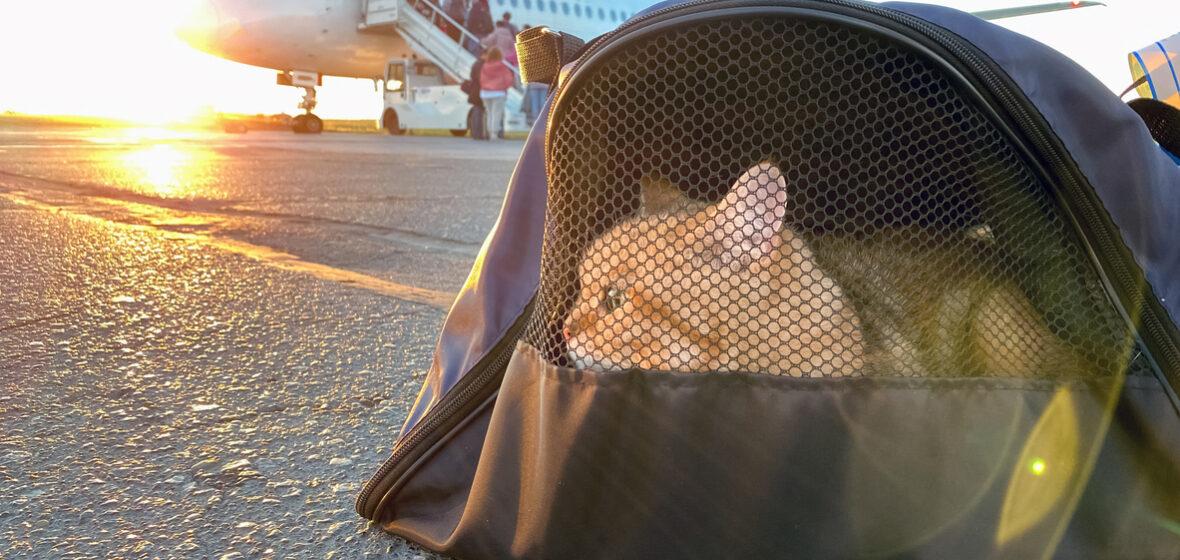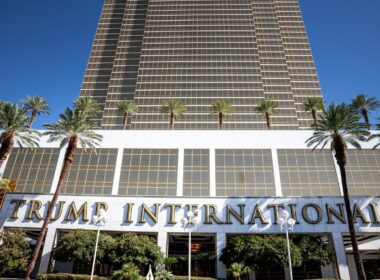While it has been legal and approved by the Australian aviation regulator, the Civil Aviation Safety Authority, for pets to fly in plane cabins for the last few years, it has not been allowed by any airlines so far. That is all set to change when Virgin Australia introduces its new policy of allowing small dogs and cats to fly in cabins with their owners, under certain conditions.
In December 2021, the Civil Aviation Safety Authority (CASA) approved dogs to fly in the cabin with owners. However, since no airlines introduced this as policy, only service dogs were approved for flying in plane cabins with other dogs and cats required to travel in crates in the cargo hold. Animals are required to undergo vet checks prior to travel, and a number of airlines already allow cargo travel, including Qantas (international and domestic), Virgin (domestic, where the weight of the dog and the crate do not exceed 65kg in total) and REX (domestic, with a maximum 30kg limit of dog and crate).
On 7 March, Virgin Australia announced it would be the first airline to offer in-cabin travel for small dogs and cats. The airline has claimed it is awaiting regulatory approval, but it expects to launch the offering within the next 12 months. It’s a long-awaited, commercially savvy plan by Virgin Australia, which points to surveys with its social media followers and Australian pet owners to ascertain a majority in favour of travelling with pets in the cabin, with many survey respondents indicating they would travel more often if they could take their pets onboard.
In a press release, Virgin indicated that pets could only fly in cabins under certain circumstances, including relegation to specific rows, specific domestic routes, and pets would be required to be contained within an approved pet carrier under the seat for the duration of the flight (pets would not be permitted to sit on laps or roam the plane).
While assistance and service animals travel within cabins free of charge, travellers who fly with their pets will be required to pay a fee.
Virgin Australia Group CEO Jayne Hrdlicka said, “Overwhelmingly, our guests tell us they want to travel with their pets, and we are now on a journey to make that a reality. It’s something that commonly happens overseas and is proven to work well.”
She added, “Almost 70 per cent of Australian households have a pet, so this announcement is really significant for a large proportion of the country. It’s also a great thing for pet-friendly accommodation providers who will benefit greatly from increased connectivity and the ease for travellers to fly with their pets. It really will be a whole new economy for pet travel in Australia.”
One of the key concerns Virgin Australia has considered is the potential for in-cabin pets to be an allergy trigger for some passengers. According to a Q&A on the Virgin Australia website, “cabin airflow dynamics (air circulating from top to bottom), the renewal of cabin air 20-30 times per hour and use of hospital grade HEPA filtration in our aircraft (which capture greater than 99% of airborne particles) mean the risk of allergy-triggering particles being circulated on-board is low. Virgin Australia currently has robust systems for guests who have severe allergies to identify themselves via the MEDA process, so that risks for these guests can be mitigated and arrangements are put in place prior to travel.”
Other passenger fears have also been aired with airlines and via social media, including the prospect of defecation and odours mid-flight, fighting, and barking.
At the time of new laws enabling pets to fly in cabins in 2021, a CASA spokesperson said, “[airlines] must consider how to restrain animals, effects on other passengers, not blocking exit rows, dealing with droppings/urine. The procedures for pets would be added to their operations manuals.”
Why Australia lags behind
Most of the major airlines in North America, Canada and many in Europe also allow pets to fly in-cabin for domestic flights. Air Canada, Alaska Airlines, American Airlines, Delta Airlines, United Airlines and many others allow pets to fly in the cabin on the proviso their carriers fit under the plane seat in front of the owner. Most airlines enable pets of up to 12kg, which exceeds the standard weight limit of 8kg on most European airlines that enable pets in the cabin.
In May 2021, CASA released an Advisory Circular regarding carriage of assistance animals, making clear that as per Regulation 91.620 of the Civil Aviation Safety Regulations 1998, the pilot in command was required to “take reasonable steps to ensure the safety of flight is not adversely affected…if the animal is to be carried in the cabin of the aircraft.”
It would be realistic to assume Virgin will adopt many of the determining factors for allowing assistance animals into the aircraft cabin in its own policy to allow pets in the cabin. Amongst the determining factors a pilot could consider in approving an assistance animal in the aircraft cabin, are “whether the animal has been trained to a standard of behaviour and hygiene that is appropriate for travel in the passenger cabin of the aircraft”, whether the owner or handler can control the animal on board the aircraft and “adequate restraint of the animal at different stages of flight”, “excreta containment”, and the presence of “passengers with allergies to, or phobia of animals”.
Within the operational guidelines which all air transport operators are required to have in regards to the carriage of animals (as per Civil Aviation Safety Regulations 1998), CASA recommended procedures include the determining factors for acceptance of animals in the aircraft cabin, how animals will be controlled to avoid negatively affecting safety of the aircraft or persons on board, and how animal excreta or water for their hydration will be contained on board to avoid spillage, causing a safety risk.
Further, the CASA advice posited that animals should not have to remain in a “tight curl” position for significant periods, and whatever space they’re assigned needs to allow for assuming other positions.
The aviation legal expert weighs in
Bradley Hayward is a partner at Vector Legal, a committee member of the NSW Branch of the Aviation Law Association of Australia and New Zealand, and an Associate Member of the Royal Aeronautical Society. Before his admission to legal practice in 2013, Brad worked for a decade in the flight operations division of a large regional airline in positions involving regulatory compliance.
He tells LSJ, “There are some interesting legal and practical issues Virgin Australia has to work through. There is not an awful lot of guidance in the CASR about this…[but] the starting point is CASR reg 91.215, which establishes that the Pilot-in-Command (PIC) has ultimate authority over the aircraft and the ‘maintenance of discipline’ of all persons on board the aircraft during the flight. In practice, an airliner has a command structure, with the Captain – the PIC – at the top, a hierarchy of pilots, being the First Officer and Second Officer, and cabin crew. Cabin crew members are cabin safety experts and are often delegated much of the ‘maintenance of discipline’ part of the Captain/PIC’s duties. However, at all times, the PIC is the final authority.”
As the final authority, the PIC has the final say on whether any animal, including service animals, can board the flight and the animal can be denied permission if the PIC deems that it will adversely affect the safety of air navigation, overruling the Disability Discrimination Act 1992.
Hayward says, “Other rules depend on the type of Air Operator’s Certificate (AOC) held by the airline. Virgin Australia holds an AOC issued under CASR Part 121, which refers to air transport operations in large aeroplanes. There are other CASR Parts that apply to small aeroplanes, rotorcraft, and other kinds of air operation. CASR reg 121.355 says only: ‘An aeroplane operator’s exposition must include procedures for the carriage of animals for a flight of the aeroplane’. In this case, the ‘exposition’ is a document submitted to the Civil Aviation Safety Authority (CASA) together with the operator’s application for an AOC, which sets out all aspects of the operator’s procedures. These are quite lengthy documents and must be kept updated by submitting any amendments to CASA as and when they are amended.”
Lastly, he says, “In practice, the airline would prepare their procedures to set out in their operations manuals (which constitute their ‘exposition’) and submit them to CASA for approval. CASA uses documents like the AC to provide guidance as to the standards that would be accepted. The procedures that ultimately make it into Virgin Australia’s manuals will set out guidance for Captains making decisions about taking animals on board.
:It would also set out steps that ground staff would be required to take to prepare and accept animals for carriage in the cabin before the Captain needs to make any ‘on the spot’ decisions about boarding, or not boarding, the animal. As you can appreciate, some care would need to be taken, since it cannot be assumed that a standard pet has been trained to the same level as an assistance animal, or that it has the same temperament.
“Passengers can expect to be required to provide some kind of certification that the pet has undergone some kind of training and has been examined by a vet to ensure it is healthy, but the detail about this has not been determined yet.”
Virgin Australia has advised pets will only be allowed on specified routes and predetermined domestic flights. Pets will only be allowed in specified rows of the aircraft. Hayward says, “Presumably, this will be rows with sufficient space, and maybe not emergency exit rows. This will necessarily mean that the number of seats allowing pets will be limited.”
Pets will not be allowed to roam the cabin, or sit on passengers’ laps, and at all times, pets must remain in their pet carrier, stowed under the seat in front of the owner.
“Essentially, they are to be treated as cabin baggage. Also, the pet carrier must be approved by Virgin Australia. I’d expect to see a list of approved brands and makes of pet carrier,” says Hayward.
For all of those vowing on social media to never to fly Virgin Australia again once pets are allowed on flights, it’s worth noting that there’s many travellers with strong opinions on crying infants or noisy children on flights. The ideal flight: quiet, peaceful and mercifully event-free is often just that, an illusory ideal. Perhaps those who vocally denounce pets on board should give a dog a bone, and just see whether Virgin can pioneer a new age of pet-friendly travel.




